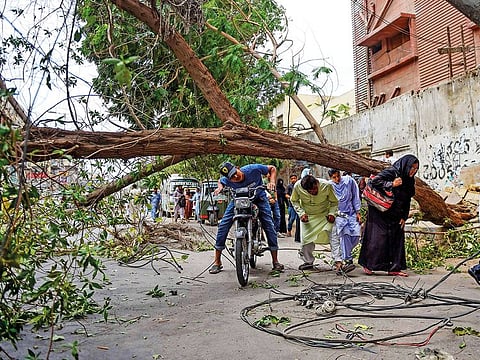Farmers devastated after hail, rain damage crops in Pakistan
The storm spoiled wheat and maize crops in the Punjab province

Islamabad: The unseasonal rain and hailstorm that lashed the country in the last three days has spelled doom for Pakistani farmers.
Farmers in Khanewal city of Punjab, known as the food basket of Pakistan, saw their crops destroyed by heavy rain and hailstorm. “It was like raining bullets from the sky. We have seen nothing like this in last 40 years,” said Syed Imran Shah, one of the devastated farmers, describing the April 15 rainstorm. He estimated 40 per cent of the wheat crop over 90 acres of land was ruined, which was ready for harvest, Shah, 44, told Gulf News by telephone. Besides the wheat, “mustard, cotton and tomato crops as well as mango and citrus orchards were also severely affected.”
Farmers in several parts of the country, particularly in the central and southern Punjab, are suffering due to torrential rains since April 14 that have reportedly damaged up to 150,000 tonnes of wheat crop. Wheat is Pakistan’s staple food grain constituting 60 per cent of the daily diet of the common man. Hailstorms particularly affected crop in Khanewal, Hasilpur, Rahim Yar Khan, Rajanpur, Dera Ghazi Khan, Muzaffargarh, Bahawalpur, Multan, Faisalabad and Jhang. The rain has also claimed 39 lives and injured 130 people across the country.
Pakistan Meteorological Department had issued alerts about severe downpour and cautioned farmers about harvesting and storage of their crop. However, these predictions usually do not reach a common farmer. “What difference would it make even if we had received precautions on time,” asks Shah, saying they don’t have “proper storage place or equipment to cover crops.” He is now demanding immediate relief from the government.
Relief demanded
After losing their standing crops to storm and unseasonal rains, farmers now seek compensation. Kissan Board Pakistan president Chaudhry Nisar Ahmad urged the government to launch a survey to assess the actual damages and compensate the growers.
“The hailstorm has not only affected the quality of standing crop but also increased harvesting cost and delayed the sowing of next crop, affecting the whole farming ecosystem,” says Aamer Hayat Bhandara, a farmer from the Pakpattan area. “Government should immediately announce a compensation package for the affected farmers and introduce crop insurance for every district.”
Government’s agriculture department has started assessing the damage in Jhang, Faisalabad and Multan regions, said Director General Agriculture (Extension), Dr Anjum Ali Buttar. However, the initial reports, according to officials, suggest significant but not total damage, which “might impact the quality of the produce but not affect the food availability in market.”
Climate change
The pre-monsoon rain has severely affected agriculturalists who were already facing higher wheat production cost. “This is fourth year that farmers are facing phenomenon of ‘pre-monsoon’, linked with climate change”, Aamer Hayat Bhandara, a young farmer, told Gulf News. Aamer, who has studied the effects of climate change, said, “More than 98 per cent of the farmers are not aware that climate change is a big issue and are unable to cope with the climatic shocks.”
The people who bring food on our table must also share the policy-making table along with researchers, experts and government officials for effective implementation of climate change policies. Overcoming the communication gap between farming community and researchers is essential to adapt, he says.
A 2018 research article ‘Farmers’ Adaptation to Climate Change in Pakistan’, after analysing data of 200 conventional farmers from Punjab province, found that majority of them do not consider climate change as a potential threat to agriculture. “If farmers realise that climate change is the reason they are losing a good part of their income, only then they will change their farming practices,” says Aamer. He suggested that farmers must be educated and trained on climate adaptation practices.
How farmers can adapt to climate change?
Experts and studies suggest following climate change adaptation measures for agricultural sector:
1. Educate and train farmers in climate-adapted cultivation practice.
2. Microcredit schemes for especially small-scale farmers to adapt to climate change.
3. Connect farmers, researchers, policy makers and business to accelerate knowledge sharing and adapt to current climate.
4. Focus on zoning and mapping of land to decrease exposure and vulnerability to natural hazards.
5. Equip farmers with latest weather forecasts and agricultural advisories on suitable harvesting techniques and ways to cope during drought and flood via phone and radio.
6. Experimenting climate-resilient varieties of crops. Change selection and timing of crops to more effectively manage projected climatic changes.
Sign up for the Daily Briefing
Get the latest news and updates straight to your inbox



